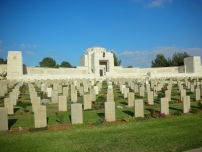| First Name: | Norman Hayes | Last Name: | BRIDGEWOOD | |
|---|---|---|---|---|
| Date of Death: | 02/11/1917 | Lived/Born In: | Knightsbridge | |
| Rank: | Private | Unit: | Essex7 | |
| Memorial Site: | Jerusalem Memorial | |||
Current Information:Born-Halifax Enlisted-Westminster
After the Western Front, the second largest theatre of war between 1914 and 1918 was Egypt and Palestine. Britain had long had a foothold in Egypt guarding the vitally important Suez Canal and when war was declared against Turkey (the Ottoman Empire) who controlled all of what is now known as the Middle East, British troops were sent to guard the canal from attacks from the north. For the first two years of the war the British forces were on the defensive as the Turks, backed by the Germans, made a number of attempts against the canal but an important victory in August 1916 at Rumani relieved the pressure and the British force was then able to move onto the offensive and advance north into Palestine. There followed the First and Second Battles of Gaza in March and in April, 1917 in which the British tried but failed to break through the Turkish line that stretched from the coast at Gaza across the desert to Beersheba. Third Battle of Gaza October-November, 1917 Throughout the hot summer of 1917, both sides strengthened their forces in Palestine and command of the Egyptian Expeditionary Force (EEF) was handed over to General Allenby who was ready to make his move at the end of October. On 31st October, British and ANZAC troops attacked and captured Beersheba and its vital water supply. Attention was now turned to Gaza where a four day artillery bombardment of the city had begun on 28th October. On 1st November, Scottish troops from 52nd Division captured Umbrella Hill, which gave them a commanding view of Gaza city and then on the night of 1st-2nd November it was attacked. The Turks fought fiercely but in the end they were overwhelmed by a numerically superior British force. By 8th November all resistance along the Gaza-Beersheba line had been broken and the route was now open for an advance on Jerusalem. However the victory had come at the cost of 2,700 British casualties including 700 either killed or missing. The action on 2nd November was never intended to capture the town, but to keep the garrison in place after the capture of Beersheba. in accordance with this the EEF attacked the southern and western defences of Gaza and captured the front line trenches there and a series of strongholds or redoubts. At 3am, 54th Division and 156 Brigade of 52nd Division attacked between the Rafa road and the sea behind the biggest barrage yet known outside the Western Front. The task of 161 Brigade was the second and third phases of an offensive that ran from the Zowaiid trench to the sea. In the second phase, the 5th Essex battalion on the right attacked Zowaiid Trench and Rafah Redoubt. This became rather confused when Rafah Redoubt was mistaken for Zowaiid Trench and caused delays. This in turn allowed the enemy to reinforce their position here which resulted in some desperate fighting for 5th Essex at Zowaiid Copse against a superior Turkish force. The battalion suffered heavy casualties, including three Lewis gun teams put out of action. They were not helped by the complete breakdown of the accompanying tanks and the great strength of a redoubt called Fred at the head of the Rafa Trench. Despite these setbacks all positions had been captured by 6.20am. On the left, the 6th Essex battalion had an easier time in their attack along the coast where Sea Post and Beach Post were soon taken. The British artillery barrage was particularly effective here and the enemy, holding out in shallow, badly constructed trenches, had little chance. In the third phase of the operation, the 7th Essex battalion passed through and resumed the attack against Rafah Trench and Cricket Redoubt. On the left Cricket Redoubt was captured but the attack on Rafah Redoubt on the right failed. It started late and although pushed with great bravery, failed to make much headway especially as the trench was enfiladed at close range by cross fire from both Junction Hill, which had been mistaken for Yunis Trench and from Fred. 161 Brigade sustained many casualties in the heavy fighting on this day, one of whom was Norman Bridgewood of 7th Essex. |
||||
| « Back to Search Results | ||||
| If you think any of the information shown here is incorrect, Click Here to submit your amends and comments | ||||




